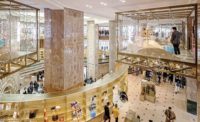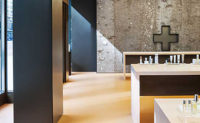Paris, France
Designing a new interior for a building as prominent as Charles Garnier's historic opera house isn't for the faint-hearted. Erected in 1875 under the auspices of Baron Haussmann's massive overhaul of Paris, the 121,000-square-foot Neo-Baroque edifice stands proudly at the intersection of Rue Scribe and Rue Auber in the middle of the city's ninth arrondissement. But these intimidating conditions did not spook architect Odile Decq. When invited to convert a cupola-covered porch into the building's first restaurant, the raven-haired designer deftly wrapped the space with a wavy curtain of glass and inserted a white mezzanine, whose sinuous form evokes the Paris Opera's infamous phantom.
Facing Place Jacques Rouche, Decq's L'Opera Restaurant is located at street level, where horse-drawn carriages once delivered their ticket-holding patrons. Today, diners approach L'Opera either from within the building or through the 170-seat restaurant's main entrance, on the building's east side. Inside, the bar and lounge area lie to the left and the main dining room is straight ahead, followed by the kitchen at the rear. Steps both in the center and at the side of the room (plus a ramp and an elevator) lead up to the mezzanine seating'mostly banquettes and semi-private dining areas sequestered by a low-lying wall.
Though it took 136 years to realize Garnier's intention for a restaurant on the opera premises, Decq had only two weeks to develop her idea. Initially, the client, a restaurant concessionaire with a 20-year contract for the Palais Garnier space, held a competition and actually selected another designer (whose name was withheld). But when the Ministry of Culture nixed the winning scheme (for management reasons), the client made a cold call to Decq, who accepted the job despite its time schedule and myriad rigid restrictions.
Because of the building's heritage, Decq could not touch its stone surfaces or block the view of the ornate pendant suspended from the domed ceiling. And to enable the space to revert to its original state, every new element had to be removable at the end of the restaurant's limited term. 'The only thing we could change was the floor,' says Decq.
Working around these constraints, the architect created a mezzanine consisting of a steel skeleton covered with white plaster molded on-site by one of France's two remaining masons with the traditional know-how. It is like an apparition wafting through the air, its mysterious form continually morphing. The mezzanine dodges or encircles the building's stone pillars, indents to keep the dome's apex visible, and tapers seamlessly down to the 15 unique columns supporting its bulk.
Contrasting sharply with its ghostly exterior, the hull-like mezzanine is startlingly bedecked entirely in red. Though partial to black, Decq agreed to cover the mezzanine's low walls, banquettes, chairs, and carpets with the bright color. 'Opera red is darker,' explains the architect. 'My shade is between orange and red.' Spilling down the stairs and pooling on the ground floor below, the carpet connects the two dining areas, stopping just short of the facade.
Tailored to the existing building, this undulating glass veil wends its way around the stone columns and soars to the curved ceiling. Ranging from 26 to 28 feet in height, it consists of two sheets of 0.4-inch-thick laminated glass. For maneuverability during construction, the wall divides vertically into two sections united by a bent steel band 20 feet above the floor. The band is invisibly anchored to the column tops by stainless steel tie rods, but the wall is practically self-supporting because of its wavy profile. 'With no visible structure, the glass is held in place as if by magic,' says Decq. While silicone joints affix the top of the glass to the ceiling, a second steel band embedded in the floor secures the wall's base.
Replacing the original, exterior-grade brick pavers, Decq used black concrete dotted with small stones. Because of a slight level change between the restaurant's interior and adjacent outdoor terrace, the preservation authorities permitted the substitution. But they accepted only modest adjustments to the ground plane, as the technical spaces in the opera's basement lurk just 5 feet below grade.
Nonetheless, the architect had to excavate to accommodate the 2-inch-thick steel plates supporting the mezzanine's columns. Each column consists of a hollow steel-mesh tube cloaked with plaster. While pockets in the masonry hold LED fixtures that cast light dramatically upward, the conduit contains ventilation shafts and electric cables. 'This is exactly what Garnier was doing in the 19th century,' explains Decq. 'A modern architect in his time, he built the opera from stone but its main structure was steel.'
Though the hollow columns can transmit sound to the stage above, ambient music was an important element befitting a restaurant in an opera house. To prevent interference with performances and offset the room's many hard surfaces, a porous, acoustically absorbent plaster coats the mezzanine's low walls and concave underbelly. In addition, carefully placed speakers let restaurant personnel fine-tune sound levels throughout and prevent excessive noise from building up at any location.
L'Opera's Decq-designed upholstered furniture also dampens sound. Circular dining chairs ringed with supportive backs and sides answered the client request for comfortable seating. Decq paired them with trapezoidal tables that can align into a single, snaking surface for buffets or banquets. In the lounge, where patrons gather at intermission, Decq introduced a squiggly continuous bench whose cushioned seat rises and falls along its length, enabling some to sit properly and others to perch. Meanwhile, a long bar made of black wood theatrically wraps itself around one of the building's big square columns.
Decq's interior harmonizes with the building's other voices'its rich history, its dramatic space, and its regal materials. At the same time, by choreographing movement and altering perceptions, it dynamically transforms a staid, centrally organized space into one with a strong contemporary character.
Cost: $8 million
Completion Date: July 2011
Gross Square Footage: 11,840 sq.ft.
Architect and Designer:
Odile Decq
Odile Decq Benoit Cornette Architectes Urbanistes
PeopleClient: GUMERY Architect and Designer: Personnel in architect's firm who should receive special credit: Facade consultants: Building services engineering: Acoustics engineering: Fire security engineering: Kitchen consultants: Project responsables: Photographer(s): Roland Halbe - ODBC Digital views: Odile Decq – Labtop |
ProductsEntreprises Façades Plâtre / Poteaux Mezzanine Sol Garde - Corps, cave à vin, vestiaires Tables Chaises Banquettes
|













Post a comment to this article
Report Abusive Comment